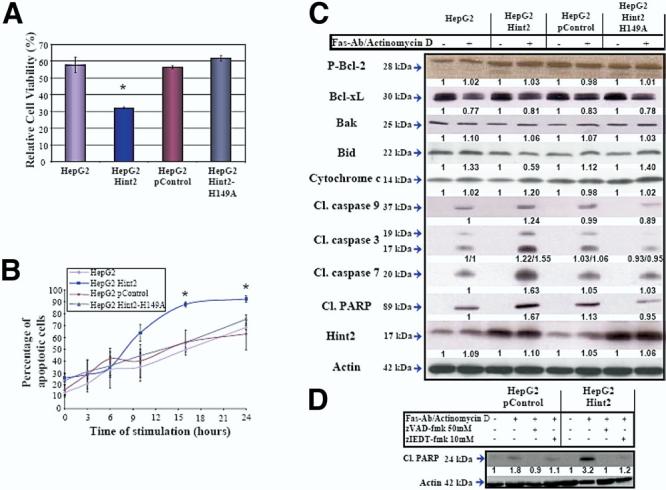Figure 5.

(A) Effect of Hint2 overexpression on cell viability. Cells were incubated for 16 hours with anti-Fas antibody (100 ng/mL) and actinomycin D (50ng/mL), and viability was assessed by the means of 3-(4,5-dimethythiazol-2-yl)-2,5-diphenyltetrazolium bromide assay. Viability was significantly lower in cells overexpressing Hint2 (32.2% ± 0.6% vs 57.7% ± 4.6%; *P < .02). (B) Cells were labeled withJC-1, a mitochondrial membrane potential marker, and fluorescent properties were analyzed by flowcytometry after 0-, 3-, 6-, 10-, 16-, and 24-hour exposure to anti-Fas antibody (100 ng/mL) and actinomycin D (50ng/mL). The percentage of cells with a dissipated mitochondrial potential was significantly higher in the case of Hint2 overexpression (87.8% ± 2.3% vs 49.7% ± 1.6% at 16 hours and 92.3% ± 2.6% vs 68.3% ± 1.8% at 24 hours; *P < .05). (C) The expression of phosphorylated Blc-2, Bcl-xL, Bak, Bid, and cytochrome c was not affected by overexpression of Hint2. More cleaved caspase-9, caspase-3, and caspase-7 and PARP were found in HepG2 cells overexpressing Hint2 in response to incubation with anti-Fas antibody (100 ng/mL) and actinomycin D (50 ng/mL) for 16hours. The figure shows immunoblots representative of 3 independent experiments. (D) Incubation with the caspase inhibitors zVAD-fmk (50 mol/L) or zIETD-fmk (10 mol/L) prevented the anti-Fas antibody–and actinomycin D–induced cleavage of PARP as assessed by immunoblot analysis.
